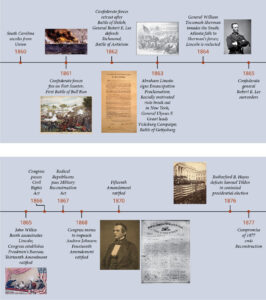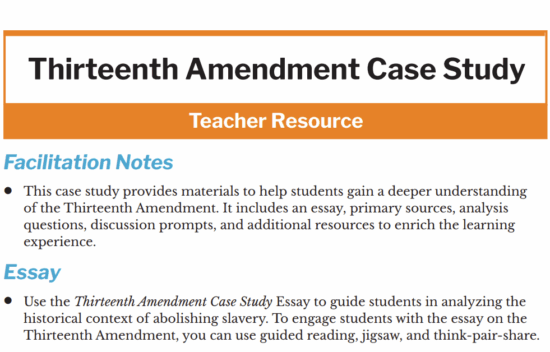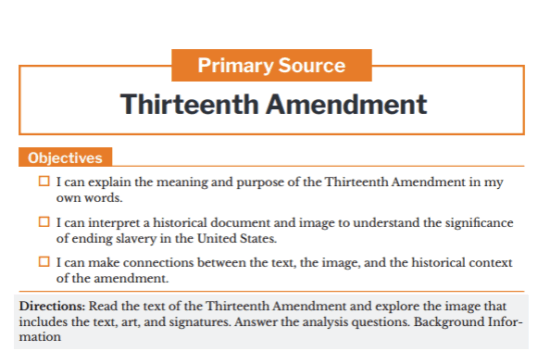Thirteenth Amendment Case Study Essay
Thirteenth Amendment Case Study Essay
Key Terms
| Vocabulary | Definition |
| Nullification Crisis | A political dispute in the 1830s in which South Carolina attempted to nullify federal tariffs, claiming the right to invalidate federal laws deemed unconstitutional. This crisis highlighted tensions between state and federal authority. |
| “slave power” | A term used by Northern abolitionists to describe the perceived political dominance of the slaveholding South in Congress and its influence on national policies. |
| Secession | The act of a state formally withdrawing from the Union, as Southern states proclaimed before and during the Civil War. |
| Confederate States of America (CSA) | A group of 11 Southern states that seceded from the United States in 1860–1861, forming a separate government to protect slavery. The CSA existed during the Civil War and was defeated by Union forces in 1865. |
| Emancipation Proclamation | An executive order issued by President Abraham Lincoln in 1863, declaring that enslaved people in Confederate-controlled areas were free. It abolished slavery and provided for enforcement powers. |
| Border states | Slaveholding states (Delaware, Kentucky, Maryland, and Missouri) that remained in the Union during the Civil War. |
| Involuntary servitude | Forced labor or service that a person must perform against their will, except as punishment for a crime. |
| Due process of the law | The legal requirement that the government must respect a person’s legal rights and follow fair procedures. |
| Poll tax | A fee required to vote, used by Southern states after Reconstruction to disenfranchise African Americans and poor whites. |
| Literacy test | A reading and writing requirement used by Southern states to restrict voting access for African Americans, often unfairly applied. |
Option A
Lexile: 1260
Word Count: 777
Vocabulary: whereof, enslaved, servitude, nullify, constitutionality, westward, duly, constitutionally
The Constitution, Secession, and the Civil War
The Constitution of the United States explained how new states could join the Union, but it did not clearly say whether states could ever leave, even though many believed the Union was meant to last forever. After the Nullification Crisis in the 1830s in which South Carolina claimed to “nullify” a congressional law on the tariff, tensions between Northern and Southern states continued to grow. Slavery and its expansion westward became the central issue dividing the two regions. Many believed that Congress made important compromises such as the Missouri Compromise and the Compromise of 1850 that would help resolve the dispute. This, however, did not happen.
As the United States expanded, the interests of Northern and Southern states became more different. The addition of new states created conflict over whether slavery would be allowed in these states. Southern states feared that Congress might pass laws to abolish slavery where it already existed or prevent its growth. Northerners, on the other hand, were concerned about the influence of the “slave power” in Congress, resented laws requiring escaped slaves to be returned to their owners, and opposed the expansion of slavery.
When Abraham Lincoln was elected president in 1860, several Southern states believed their way of life was under threat because of statements Lincoln made about the evils of slavery. In January 1861, South Carolina became the first state to secede from the Union. It declared its secession in a document that used the language of the Declaration of Independence. Ten more Southern states soon followed, forming the Confederate States of America (CSA). President Lincoln, however, did not recognize the CSA as a separate nation. Instead, he viewed the Southern states as being in rebellion against the United States and used his presidential powers to suppress the rebellion.
The Emancipation Proclamation
Two years after the Civil War began, President Lincoln issued the Emancipation Proclamation and used his emergency war powers to end an institution he thought violated natural rights and American principles. By grounding it in both the Constitution’s war powers and the nation’s founding ideals of liberty and equality, Lincoln transformed the war into a moral fight for freedom and redefined the meaning of the Union. This document declared that enslaved people in the Confederate states that were not under Union control were “forever free” and provided for the executive and armed forces to enforce it. The proclamation also allowed formerly enslaved men to join the Union army. Lincoln believed this would help strengthen the Union’s fight against the Confederacy.
The Emancipation Proclamation did not apply to enslaved people in the border states (Delaware, Kentucky, Maryland, and Missouri) that had remained loyal to the Union because neither the president nor the Congress had constitutional authority over slavery in those states. In addition, Lincoln did not want to alienate those states because of their strategic locations. It also did not apply to areas of Confederate states that were already under Union control because Lincoln did not have the authority to apply the Emancipation Proclamation to these areas since they were no longer in rebellion. In those places, slavery was to remain “precisely as if this proclamation were not issued.”
The Emancipation Proclamation was an important, revolutionary step toward ending slavery in the United States. Because it was a wartime measure, Lincoln feared that the authority would end with the end of the war. He also feared the Supreme Court would challenge its constitutionality. Therefore, he urged Congress to pass the Thirteenth Amendment forever ending slavery constitutionally.
The Thirteenth Amendment
The Thirteenth Amendment, ratified in 1865, ended slavery throughout the United States and made it illegal forever. It states:
“Neither slavery nor involuntary servitude, except as a punishment for crime whereof the party shall have been duly convicted, shall exist within the United States.”
This amendment ensured that slavery could never exist in any part of the country. The Thirteenth Amendment permanently abolished slavery everywhere in the United States as a matter of fundamental law.
Reconstruction and Additional Amendments
After the Civil War ended, Congress required Southern states to approve Thirteenth Amendment and two other important amendments before rejoining the Union:
- The Fourteenth Amendment (1868) ensured that all people born in the United States were citizens. It also guaranteed that states could not deny any person “equal protection of the laws” or take away their rights without “due process of law.”
- The Fifteenth Amendment (1870) protected the right to vote for all men, regardless of race, color, or previous condition of servitude.
These amendments were meant to protect the civil rights of African Americans and ensure equality under the law. However, by the 1890s, Southern states found ways to prevent African Americans from voting, using poll taxes, literacy tests, and other unfair measures.
Option B
Lexile: 1050
Word Count: 500
Vocabulary: rejoin, confederate, unfair, slavery, worried, slave, separate, escape, amendment
The Constitution and the Civil War
The Constitution explained how states could join the United States, but it did not clearly say if states could leave. Many believed the country should stay together forever. In the 1830s, South Carolina tried to stop a law that Congress made. After that, the North and South had more and more problems with each other. The biggest problem was about slavery and whether it should be allowed in new areas in the West. People thought some agreements, like the Missouri Compromise and the Compromise of 1850, would help solve these problems. But they did not.
As the United States grew bigger, the North and South became more different. When new states joined the country, they argued about whether these states should allow slavery. The South was afraid Congress might make laws to end slavery or stop it from spreading. The North did not like slavery and did not want to return escaped slaves to their owners.
When Abraham Lincoln became president in 1860, some Southern states were worried because Lincoln had said slavery was wrong. In December 1860, South Carolina was the first state to leave the Union. Ten more Southern states soon followed and formed the Confederate States of America (CSA). President Lincoln did not agree that they could be a separate country. He thought they were just fighting against the United States, and he used his power as president to stop them.
The Emancipation Proclamation
Two years after the Civil War started, President Lincoln made the Emancipation Proclamation. It said that slaves in Confederate states that were not under Union control would be free. It also let freed slaves join the Union army. Lincoln thought this would help make the Union stronger.
The Emancipation Proclamation did not free slaves in states that stayed with the Union, like Delaware, Kentucky, Maryland, and Missouri. Lincoln could not change the laws about slavery in these states. It also did not free slaves in Confederate areas that the Union army already controlled.
The Emancipation Proclamation was a big step toward ending slavery in America. Lincoln wanted to make sure slavery would end forever, so he asked Congress to pass the Thirteenth Amendment.
The Thirteenth Amendment
The Thirteenth Amendment, which became law in 1865, ended slavery in all of America forever. It says that no one can be forced to be a slave in the United States.
Reconstruction and New Amendments
After the Civil War, Congress made Southern states accept the Thirteenth Amendment and two other important amendments before they could rejoin the Union:
The Fourteenth Amendment (1868) made sure that everyone born in America was a citizen and had equal rights under the law.
The Fifteenth Amendment (1870) gave all men the right to vote, no matter what their race was.
These amendments were supposed to protect African Americans’ rights. But by the 1890s, Southern states found unfair ways to stop African Americans from voting, like making them pay special taxes or take hard tests.
Images

https://billofrightsinstitute.org/essays/chapter-8-introductory-essay-1860-1877
The Civil War was fought at enormous cost. Rebuilding and reunifying the nation was incredibly complex and brought both success and failure.

